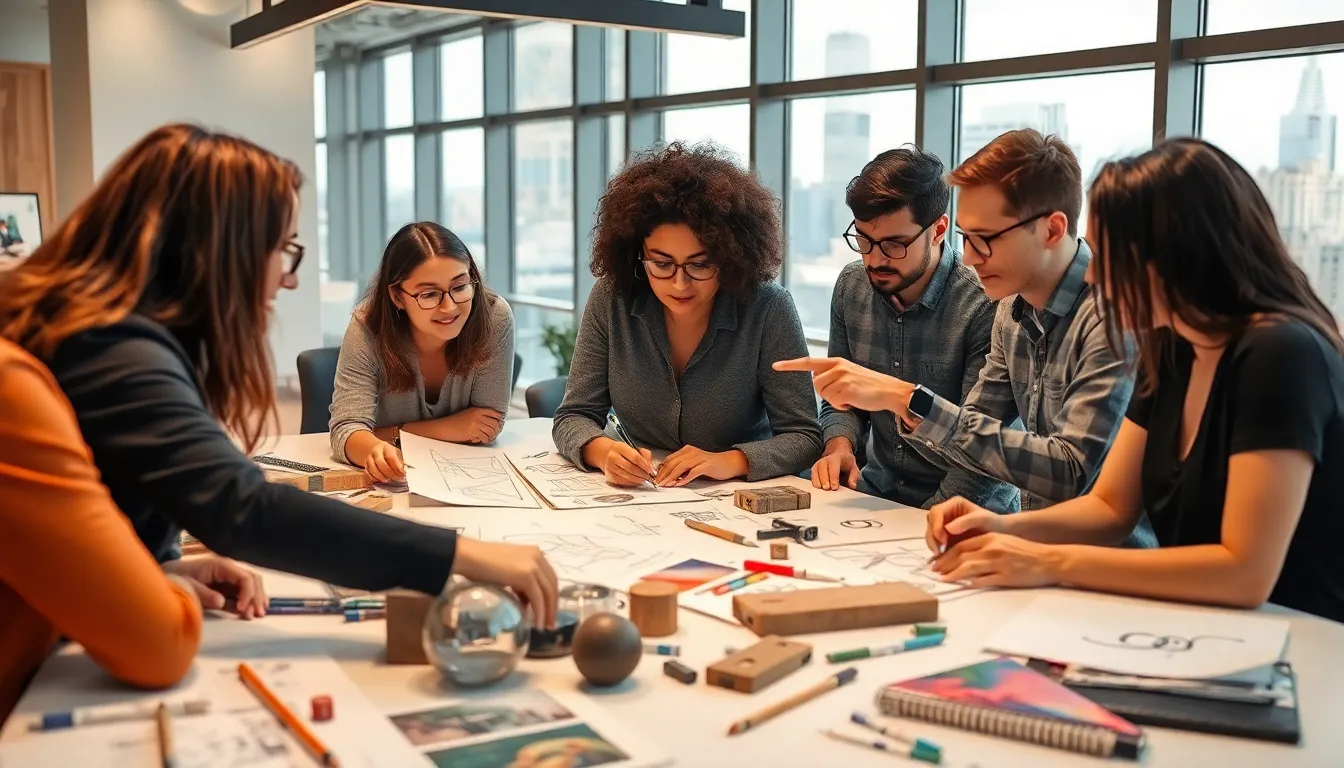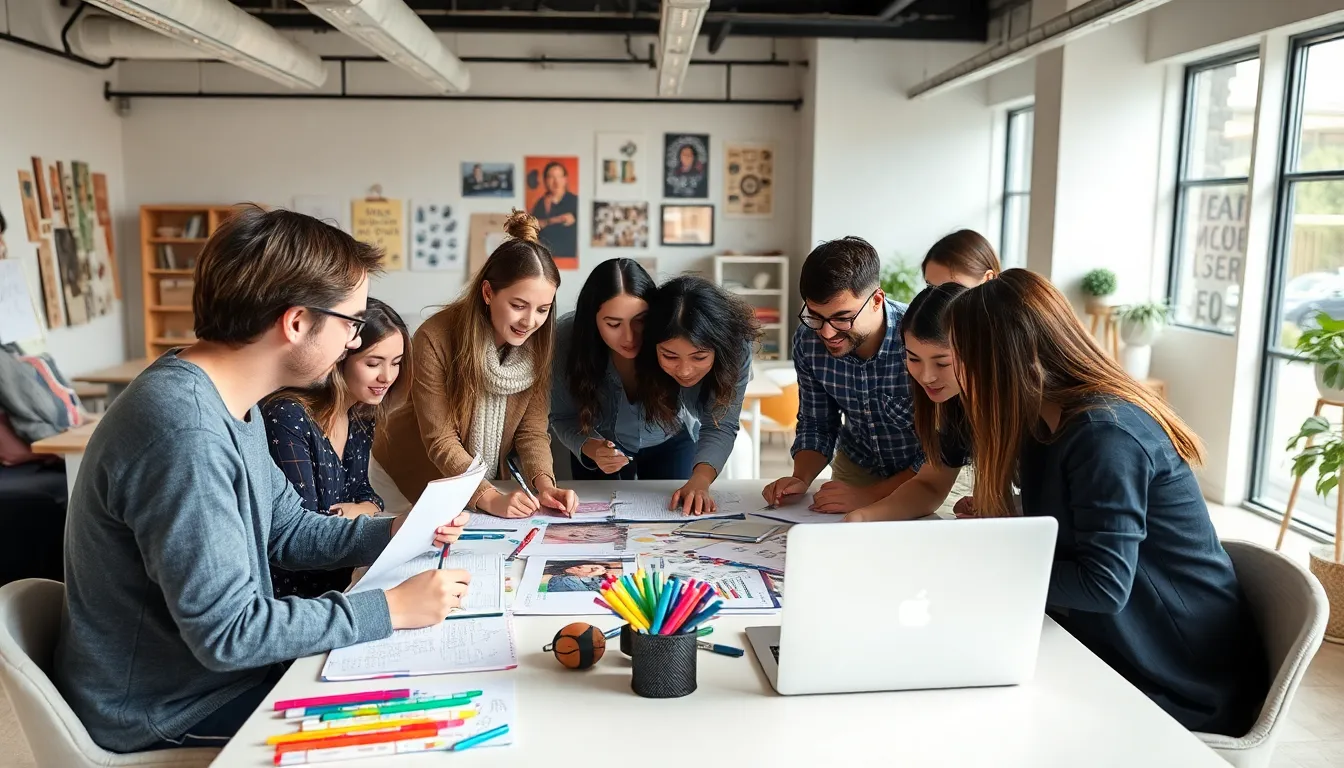In a world where creativity knows no bounds, design exploration is the thrilling adventure every creator needs. Imagine diving into a vibrant ocean of ideas, where each wave brings a fresh perspective and every splash inspires innovation. It’s not just about sketching pretty pictures; it’s about uncovering the hidden gems that can transform mundane concepts into extraordinary masterpieces.
Whether you’re a seasoned designer or just dipping your toes into the creative waters, embracing design exploration can be the key to unlocking your full potential. So grab your metaphorical snorkel and dive in! Get ready to discover new techniques, challenge the status quo, and maybe even find that one quirky idea that makes everyone say, “Why didn’t I think of that?” Join the journey and see how design exploration can turn your creative chaos into a symphony of brilliance.
Table of Contents
ToggleOverview of Design Exploration
Design exploration serves as a critical journey for creators. Through this process, individuals delve into a vast array of ideas that can spark innovative breakthroughs. Creativity thrives beyond mere aesthetics, focusing instead on discovering unique concepts that can transform ordinary ideas into extraordinary works. Engaging in design exploration opens pathways to new perspectives and solutions.
Gathering inspiration from various sources is essential during this phase. Teams or individuals can draw insights from art, technology, nature, and cultural trends. Each source contributes dynamic elements that enrich the design process. The exploration phase encourages experimentation with different styles, materials, and methods.
Iterative processes play a significant role in refining ideas. By sketching, prototyping, and testing concepts, designers uncover effective solutions that align with their vision. Feedback loops from peers or target audiences can provide valuable insights, guiding further iterations.
Incorporating diverse viewpoints fosters creativity. Including team members from various backgrounds, skill sets, and disciplines promotes a richer exploration. This collaboration results in a comprehensive understanding of the problem space, generating a multitude of viable solutions.
Ultimately, design exploration empowers creators to break free from conventional constraints. Venturing into uncharted territories of thought can lead to captivating innovations. By embracing both success and failure, designers cultivate resilience that propels their work to new heights. This journey is not just about finding answers but also about exploring questions that challenge the status quo.
Importance of Design Exploration

Design exploration is crucial for unlocking innovative potential. It cultivates original ideas and elevates concepts beyond conventional limitations.
Enhancing Creativity
Creative thinking flourishes during the design exploration process. Diverse sources of inspiration, including art, technology, and nature, spark fresh ideas. Collaborating with team members enriches this creativity by incorporating varied perspectives. Experimentation with different materials and methods often leads to unexpected breakthroughs. Iterating through sketches and prototypes provides clarity, encouraging designers to push boundaries. Embracing both successes and failures helps creators develop resilience, fostering an environment where innovative thoughts thrive.
Problem-Solving Approaches
Design exploration serves as a vital tool for effective problem-solving. It encourages a deep dive into the problem space, which helps identify core issues. Generating multiple concepts allows for wider exploration of possible solutions. Feedback loops, including insights from peers and target audiences, sharpen these approaches. Iterative testing refines ideas, ensuring that solutions resonate deeply with users. By examining problems from various angles, designers unlock transformative insights. Engaging with different methodologies leads to well-rounded strategies that address complex challenges more efficiently.
Methods of Design Exploration
The exploration phase encompasses various methods that enhance the design process. These techniques encourage creativity and ensure comprehensive development.
Sketching and Prototyping
Sketching serves as a quick way to visualize ideas. Designers generate multiple concepts rapidly, allowing flexibility in thought. Prototyping transforms sketches into tangible representations. Various fidelity levels, from paper models to digital interfaces, facilitate feedback. Creating low-fidelity prototypes early streamlines the iteration process. Rapid iterations help teams refine ideas based on immediate insights. Engaging with sketches and prototypes fosters collaboration and clarity.
User Research and Feedback
User research illuminates the needs and preferences of the target audience. Engaging users through surveys, interviews, and observation delivers valuable insights. Gathering data informs design choices and enhances relevance. Feedback loops further guide the design exploration process. Iterating based on user input allows teams to identify pain points and preferences. Understanding users informs adjustments that improve user experience. Emphasizing this research ensures solutions resonate with the intended audience.
Tools for Effective Design Exploration
Design exploration benefits greatly from a variety of tools. Both digital tools and traditional techniques play crucial roles in fostering creativity and facilitating the design process.
Digital Tools
Software applications enhance the efficiency of design exploration. Programs like Adobe Creative Suite offer powerful functionalities for creating visually stunning graphics. Tools such as Sketch and Figma allow for collaborative wireframing and prototyping, streamlining feedback from team members. Online platforms like Miro enable brainstorming sessions with visual collaboration features, driving innovative ideas. User testing tools such as UsabilityHub provide insights into how real users interact with designs, ensuring informed adjustments. By leveraging these digital resources, designers keep their ideas organized and accessible, fostering a productive exploration environment.
Traditional Techniques
Sketching provides an immediate avenue for articulating concepts visually. Designers often use pen and paper to capture spontaneous ideas without the constraints of software. Mood boards serve as inspirational collages, helping to establish visual direction through curated images and materials. Brainstorming sessions encourage team collaboration, tapping into diverse perspectives to generate a wealth of ideas. Additionally, physical prototypes, created with simple materials like cardboard or clay, help designers visualize form and function early in the process. By incorporating traditional techniques, designers connect with their ideas more tangibly, resulting in a richer exploration experience.
Challenges in Design Exploration
Design exploration faces several challenges that can hinder the creative process. A lack of clear objectives often leads to confusion and wasted time. Designers may struggle to find inspiration, feeling overwhelmed by an abundance of ideas. Limited resources, whether time, budget, or tools, can also restrict innovative thinking. Navigating conflicting feedback from team members complicates decision-making, impeding progress.
Common Obstacles
Common obstacles in design exploration include ambiguity in project goals and insufficient user feedback. Difficulty in synthesizing diverse input can lead to indecision, while time constraints hinder thorough exploration of ideas. Misaligned team priorities may create friction, resulting in diluted focus. Furthermore, overemphasis on perfection during early stages stifles creativity and experimentation.
Strategies for Overcoming Challenges
Implementing clear communication strategies enhances team collaboration. Setting specific, measurable goals streamlines the design process, facilitating focused exploration. Investing in user research ensures designers gain valuable insights, driving informed decisions. Embracing flexibility during iterations allows for adjustments in response to evolving feedback. Prioritizing rapid prototyping encourages experimentation, enabling quicker validation of concepts while fostering a culture of creativity.
Design exploration isn’t just a phase; it’s a crucial mindset that empowers creators to push boundaries and uncover innovative solutions. By embracing diverse sources of inspiration and fostering collaboration, designers can transform ordinary concepts into extraordinary realities. The iterative nature of this process not only sharpens ideas but also deepens understanding of user needs.
While challenges like unclear objectives and limited resources may arise, adopting clear communication and setting measurable goals can pave the way for effective exploration. The combination of digital tools and traditional techniques enhances creativity and efficiency, making it easier to visualize and refine ideas. Ultimately, design exploration serves as a powerful catalyst for innovation, encouraging designers to venture into uncharted territories and redefine what’s possible.

